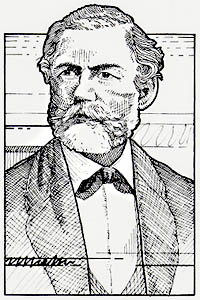William Sellers (1824-1905)
Sellers started in Philadelphia in partnership with William Bancroft, in a firm in which Bancroft was the innovator. After Bancroft’s death, Sellers took the lead in innovation: the first of what would amount to 90 patents was issued to him in 1897. Sellers had started with the purpose of building machine tools, making them heavier than they had been made by others. He was one of the first to abandon the beads, moldings, and embellishments. He painted them gray. In 1862, he developed a planer with a rack- and-pinion worm drive to provide uniform table motion. In 1864, he proposed a standard thread form with a flat top and bottom that came into widespread use and eventually became an international standard. He played a leading role in the development of the Centennial Exhibition in Philadelphia and saw to it that the exhibits concentrated on the American achievements in machinery. For ten years he financed Frederick W. Taylor’s metal cutting research. His company built a large multiple punch for structural forms that produced hole patterns indicated by a punched paper tape that actuated pneumatic punches, a forerunner of modern NC.
Elected 1992


 Machine Tool Builder
Machine Tool Builder
 Inventor
Inventor